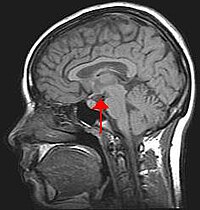
Photo from wikipedia
The orexin (Orx) system plays a critical role in drug addiction and reward-related behaviors. The dynorphin (Dyn) system promotes depressive-like behavior and plays a key role in the aversive effects… Click to show full abstract
The orexin (Orx) system plays a critical role in drug addiction and reward-related behaviors. The dynorphin (Dyn) system promotes depressive-like behavior and plays a key role in the aversive effects of stress. Orx and Dyn are co-released and have opposing functions in reward and motivation in the ventral tegmental area (VTA). Previous studies suggested that OrxA transmission in the posterior paraventricular nucleus of the thalamus (pPVT) participates in cocaine-seeking behavior. This study determined whether Orx and Dyn interact in the pPVT. Using the brain slice preparation for cellular recordings, superfusion of DynA onto pPVT neurons decreased the frequency of spontaneous and miniature excitatory postsynaptic currents (s/mEPSCs). OrxA increased the frequency of sEPSCs but had no effect on mEPSCs, suggesting a network-driven effect of OrxA. The amplitudes of s/mEPSCs were unaffected by the peptides, indicating a presynaptic action on glutamate release. Augmentation of OrxA-induced glutamate release was reversed by DynA. Utilizing a behavioral approach, separate groups of male Wistar rats were trained to self-administer cocaine or sweetened condensed milk (SCM). After extinction, rats received intra-pPVT administration of OrxA±DynA±the κ-opioid receptor antagonist nor-binaltorphimine (NorBNI) under extinction conditions. OrxA reinstated cocaine- and SCM-seeking behavior, with a greater effect in cocaine animals. DynA blocked OrxA-induced cocaine seeking but not SCM seeking. NorBNI did not induce or potentiate cocaine-seeking behavior induced by OrxA but reversed DynA effect. This indicates that the κ-opioid system in the pPVT counteracts OrxA-induced cocaine seeking, suggesting a novel therapeutic target to prevent cocaine relapse.
Journal Title: Neuropsychopharmacology
Year Published: 2018
Link to full text (if available)
Share on Social Media: Sign Up to like & get
recommendations!